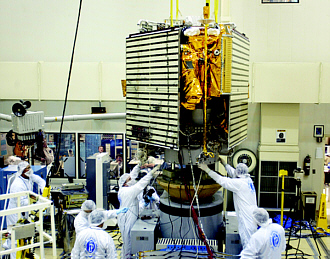MESSENGER Shipped to Goddard for Prelaunch
Tests

Engineers prepare the MESSENGER
spacecraft for a vibration test at APL, where the
Mercury-bound NASA spacecraft was designed and built.
Conducted on a shake table, the test checks the
spacecraft's structural integrity by simulating a rough
ride atop a launch vehicle.
PHOTO BY APPLIED PHYSICS
LABORATORY
|
By Michael Buckley
Applied Physics
Laboratory
Less than six months from its scheduled launch to Mercury,
NASA's MESSENGER spacecraft is set for the next round of
tests to prepare it for the first orbital study of the
innermost planet.
MESSENGER was shipped Dec. 19 from the JHU
Applied Physics
Laboratory — where it was designed and built
— to the environmental testing facilities at NASA's
Goddard Space Flight Center in Greenbelt, Md. The 20-mile
delivery capped nearly four years of detailed design,
assembly and testing on one of the most complex spacecraft
APL has ever built. With features ranging from a
lightweight composite structure and miniaturized
instruments to a heat-radiation system and protective
ceramic-fabric sunshade,
MESSENGER (short
for MErcury Surface, Space ENvironment, Geochemistry and
Ranging) is well-equipped for a five-year cruise through
the inner solar system and a yearlong study of Mercury
starting in July 2009.
"We're sending a spacecraft to orbit a planet where the sun
is 11 times brighter than what we see on Earth, and
temperatures can climb past 800 degrees Fahrenheit," said
APL's David G. Grant, MESSENGER project manager. "This is
an incredible engineering and scientific challenge that no
one has ever tried before, and the team is doing all it can
on the ground to make sure MESSENGER succeeds at
Mercury."
The first of MESSENGER's "shake and bake" tests was at APL,
where engineers checked the spacecraft's structural
strength atop large vibration tables. Over the next 10
weeks at Goddard the team will check MESSENGER's balance
and alignment, put it before speakers that simulate the
noise-induced vibrations of launch and seal it in a large
thermal-vacuum chamber that duplicates the extreme heat,
cold and airless conditions of space. In March, MESSENGER
will be sent to Kennedy Space Center/Cape Canaveral Air
Force Station, Fla., and be prepared for its May launch
aboard a Boeing Delta II rocket.
"Each part of the spacecraft has passed individual
vibration and environmental tests, and under tougher
conditions than we expect they will see at Mercury," said
James C. Leary, MESSENGER mission systems engineer at APL.
"Now we're looking at MESSENGER as a whole system. By the
time it launches MESSENGER will have been thoroughly
tested."
Carrying seven scientific instruments — including a
camera, laser altimeter, magnetometer and several
spectrometers — the solar-powered MESSENGER will
image Mercury globally for the first time. It also will
gather data on the composition and structure of Mercury's
crust, its geologic history, the nature of its thin
atmosphere and active magnetosphere, and the makeup of its
core and polar materials. While cruising to Mercury, the
spacecraft will fly past the planet twice, in 2007 and
2008, snapping pictures and gathering data critical to
planning the orbit study.
Sean C. Solomon of the Carnegie Institution of Washington
leads MESSENGER as principal investigator; APL manages the
mission for NASA's Office of Space Science and will operate
the spacecraft. GenCorp Aerojet, Sacramento, Calif., and
Composite Optics, San Diego, provided MESSENGER's
propulsion system and composite structure, respectively.
APL, Goddard Space Flight Center, University of Michigan,
Ann Arbor, and University of Colorado, Boulder, built the
spacecraft's scientific instruments.
For more information on MESSENGER, go to
messenger.jhuapl.edu.
 GO TO JANUARY 5, 2004
TABLE OF CONTENTS.
GO TO JANUARY 5, 2004
TABLE OF CONTENTS.
 GO TO THE GAZETTE
FRONT PAGE.
GO TO THE GAZETTE
FRONT PAGE.
|